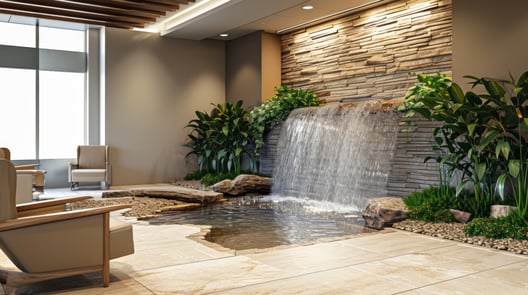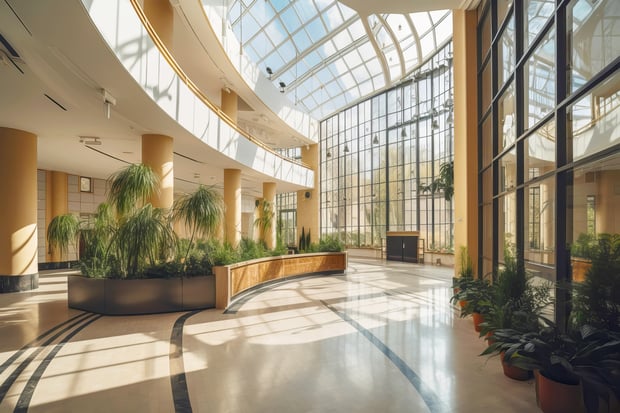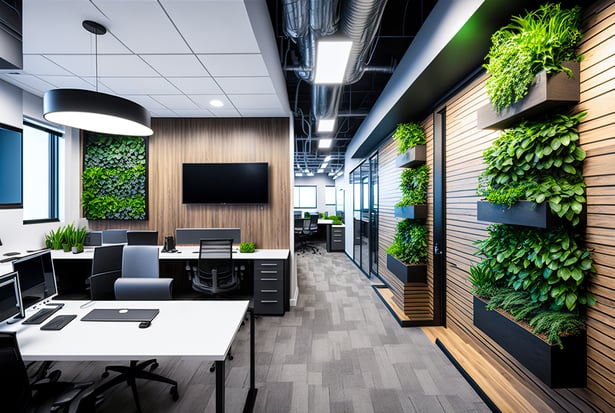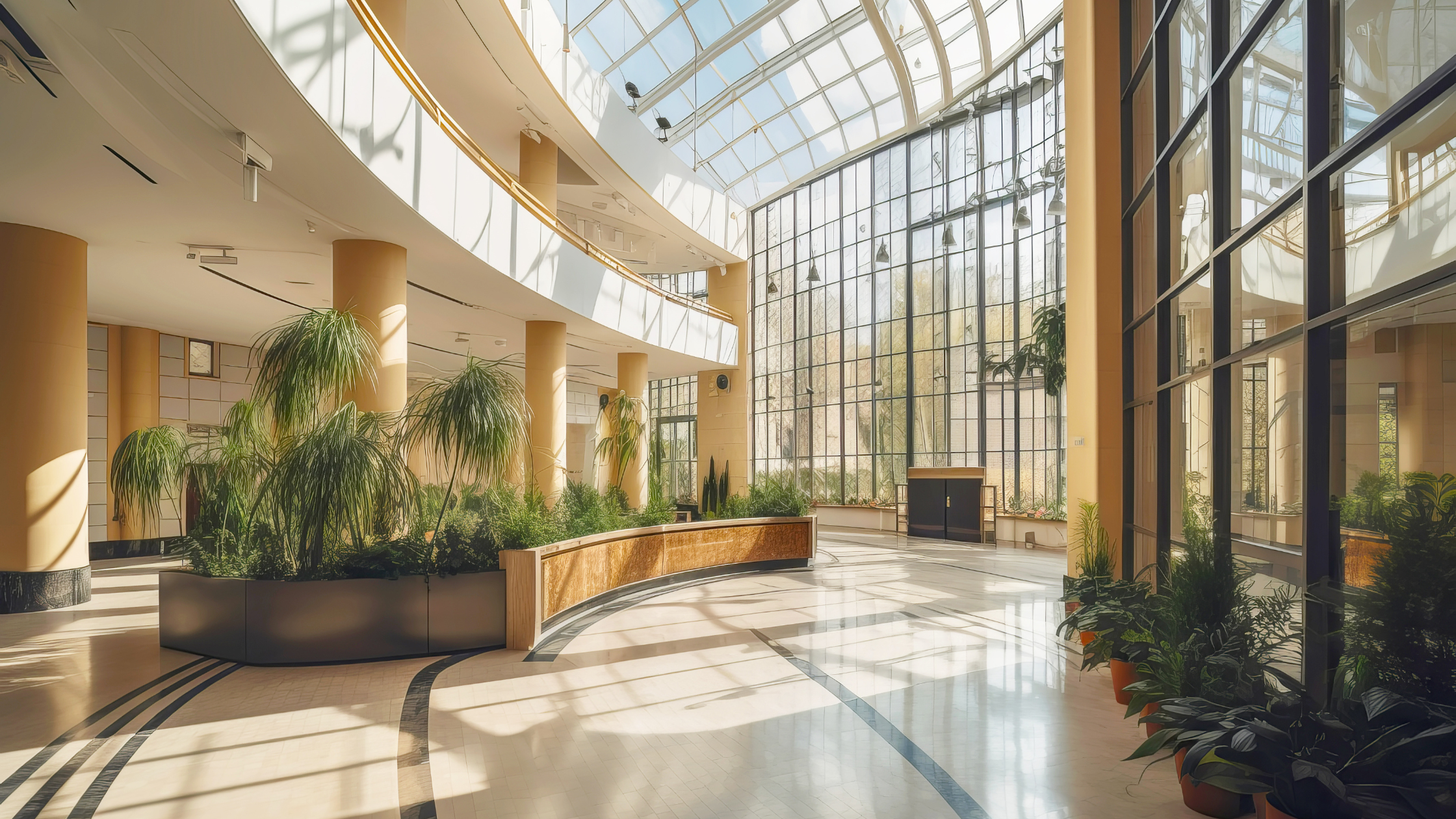The modern workplace often consists of sterile walls, harsh lighting, and artificial environments. While functional, these spaces can leave employees feeling disconnected from nature, drained of energy, and even susceptible to stress and health concerns. Thankfully, biophilic design offers a refreshing solution, integrating elements of the natural world into indoor spaces to improve employee well-being, safety, and overall productivity.
Biophilic Design: Beyond Greenery, a Connection to Nature’s Essence
Biophilic design goes beyond simply adding a few potted plants to an office. It’s a deeply rooted philosophy that acknowledges our innate human connection with nature and seeks to replicate its restorative and stimulating features within the built environment. It’s not just about aesthetics; it’s about harnessing the power of nature to create spaces that support human health, well-being, and performance. in the following ways:
More Than Just Plants
While greenery plays a significant role, biophilic design encompasses a wider spectrum of elements:
- Sensory experiences: Integrating sights, sounds, smells, textures, and even tastes of nature into the space. Think natural light filtering through leaves, the calming sound of a water feature, the earthy aroma of wood, the smooth texture of stone, or even incorporating edible gardens for a taste of nature.
- Spatial and organizational patterns: Mimicking natural forms and processes in the design layout. Imagine curved pathways inspired by rivers, open spaces echoing meadows, or even biomorphic furniture reminiscent of organic shapes.
- Non-living natural materials: Utilizing elements like wood, stone, water, bamboo, or recycled materials that evoke the essence of nature, even in their non-living state.
- Dynamic processes: Incorporating elements that change and evolve over time, mirroring the dynamism of natural ecosystems. Imagine a butterfly garden showcasing metamorphosis, a rooftop garden reflecting seasonal changes, or even dynamic lighting mimicking the sun’s movement.

The Benefits Go Beyond Aesthetics
Research shows that incorporating these biophilic elements into the workplace can lead to:
-
Reduced Stress and Anxiety
-
- Physiological evidence: Studies show exposure to natural elements like sunlight and plants reduces cortisol levels, the stress hormone, leading to calmer and more relaxed employees. One study published in the Journal of Environmental Psychology found that participants exposed to natural light had lower cortisol levels and reported feeling more relaxed than those working under artificial light.
- Improved mental well-being: Research conducted by the Human Spaces research group revealed that employees in workplaces with strong biophilic features reported lower levels of stress and anxiety compared to those working in conventional office environments.
- Enhanced Cognitive Function
-
- Boosting attention and focus: A study published in the journal Environment and Behavior found that students studying in classrooms with views of nature had significantly better attention spans and focus compared to those in classrooms without such views.
- Improved memory and learning: Research at the University of Exeter showed that employees working in environments with plants performed better on memory and attention tests compared to those in plant-free environments.
- Increased Productivity
-
- Enhanced creativity and innovation: The same Human Spaces study mentioned earlier revealed that workplaces with strong biophilic elements increased employee creativity by 15% compared to conventional office spaces. Another study published in the International Journal of Workplace Health Management found that employees exposed to natural light reported higher levels of engagement and productivity.
-
- Reduced presenteeism: Biophilic workplaces can lead to fewer employees presenteeism (being physically present but mentally disengaged), as improved well-being reduces fatigue and promotes focus.
- Lowered Absenteeism
-
- Improved physical health: Exposure to natural elements like sunlight and plants can enhance immune function and reduce the risk of common illnesses, leading to fewer sick days. Research by the UK Green Building Council found that employees in workplaces with good access to daylight reported 18% fewer sick days compared to those with limited access.
- Reduced stress and burnout: By lowering stress levels and enhancing overall well-being, biophilic design can decrease burnout and foster a healthier workforce, leading to fewer absences.
- Enhanced Safety
-
- Improved wayfinding: Biophilic design can utilize natural elements like sunlight and water features to create intuitive pathways and signage, reducing confusion and potential accidents.
- Reduced thermal discomfort: Proper use of natural light and ventilation can create a more comfortable and thermally neutral workspace, reducing fatigue and potential heat-related illnesses.
- Promoted physical activity: Access to natural elements like gardens and green spaces can encourage employees to take breaks and move around, improving overall health and reducing risks associated with a sedentary lifestyle.
Remember: This research highlights the compelling evidence linking biophilic design to numerous benefits for workplace well-being, safety, and productivity. By incorporating nature into your work environment, you can create a space that fosters a healthy, engaged, and productive workforce, ultimately contributing to the success of your organization.
Practical Guidance for Biophilic Design Implementation
Implementing biophilic design doesn’t require a complete overhaul of your office. Biophilic design isn’t just about aesthetics; it’s about strategically harnessing the power of nature to create a healthier, happier, and more productive work environment. While the possibilities are endless, here are some practical steps to guide you:
- Start Small and Assess Your Space
-
- Evaluate your existing space: Identify areas with potential for incorporating biophilic elements. Consider factors like access to natural light, available space, and employee needs.
- Begin with small, achievable changes: Adding plants to common areas, installing natural light fixtures, or introducing water features like small fountains can create a noticeable impact with minimal investment.
- Involve your employees: Conduct surveys or workshops to gather feedback on their preferences and desired elements of nature in the workspace.
- Focus on Sensory Experiences
-
- Sight: Maximize natural light with skylights, strategically placed windows, or light shelves that reflect sunlight deeper into the space. Utilize biomorphic furniture with organic shapes or nature-inspired artwork.
- Sound: Introduce the calming sounds of nature with water features, bird feeders, or nature soundscapes played at low volumes. Create quiet zones with sound-absorbing materials like plants or soft furnishings.
- Smell: Integrate natural scents like essential oils diffused in common areas or incorporate plants with pleasant aromas like lavender or rosemary. Ensure scents are subtle and unobtrusive.
- Touch: Utilize natural materials like wood, stone, or recycled materials for furniture, flooring, and décor. Provide access to green spaces or sensory gardens with diverse textures for employees to explore.
-
- Taste: Consider edible gardens or vertical herb walls, allowing employees to connect with nature through taste. Ensure proper hygiene and access to washing facilities.
- Go Beyond Plants (But Don’t Neglect Them)
Plants are vital, but there’s more to biophilic design. Explore aspects of design like:
-
- Water features: Install fountains, water walls, or aquariums to add calming sounds and visual interest. Ensure proper maintenance and hygiene.
- Natural materials: Utilize wood, stone, bamboo, or recycled materials for furniture, décor, and flooring. Consider reclaimed wood or sustainable sourcing practices.
- Dynamic processes: Create living walls, incorporate seasonal changes in décor, or install dynamic lighting mimicking the sun’s movement.

- Seek Expert Guidance
Biophilic design consultants and architects can offer tailored solutions, ensure adherence to best practices, and help navigate space limitations.
- Measure and Adapt
Monitor changes in employee well-being, productivity, and absenteeism to assess the impact of your biophilic design elements. Use feedback to continually adapt and improve your space.
Overall Things to Remember
Each of the above points is crucial to a biophilic office overhaul. However, you should also keep the following facets in mind when considering how to create a more human-centric work environment:
- Prioritize function over aesthetics: Ensure chosen elements complement the workspace’s functionality and user needs.
- Consider scalability: Plan for future expansion or changes when implementing biophilic elements.
- Maintenance is key: Regularly maintain plants, water features, and natural materials to ensure a healthy and aesthetically pleasing environment.
By embracing these steps and staying flexible, you can bring the restorative power of nature into your workplace, creating a space that nourishes the well-being of your employees and the success of your organization.
Conclusion: Cultivating a Thriving Future with Biophilic Design

The evidence is clear: incorporating biophilic design elements into the workplace is not just a fad, it’s an investment in the well-being, productivity, and ultimately, the success of your organization. By bringing the essence of nature indoors, we can foster a work environment that:
- Nourishes physical and mental health: Reduced stress, improved cognitive function, and boosted immunity lead to a healthier, more resilient workforce.
- Enhances focus and creativity: Employees in biophilic spaces experience better attention, memory, and innovation, driving productivity and organizational growth.
- Promotes engagement and well-being: A connection with nature fosters happier, more engaged employees, reducing turnover and creating a thriving workplace culture.
- Contributes to a sustainable future: Biophilic design often utilizes natural materials, promotes resource efficiency, and connects us to the natural world, aligning with broader sustainability goals.
Remember, the journey to a biophilic workplace is an ongoing process. Start small, gather feedback, experiment with different elements, and measure the impact. Every step you take, every plant you add, every natural light source you introduce, brings you closer to creating a space that benefits not just your employees, but also the planet we all share.

